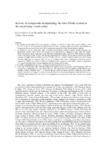Actions of compounds manipulating the nitric Oxide system in the cat primary visual cortex

Ver/Abrir
Use este enlace para citar
http://hdl.handle.net/2183/14600Colecciones
- Investigación (FCS) [1293]
Metadatos
Mostrar el registro completo del ítemTítulo
Actions of compounds manipulating the nitric Oxide system in the cat primary visual cortexAutor(es)
Fecha
1997-10Cita bibliográfica
Cudeiro J, Rivadulla C, Rodríguez R, Grieve KL, Martínez-Conde S, Acuña C. Actions of compounds manipulating the nitric Oxide system in the cat primary visual cortex. J Physiol. 1997;504(2):467-478.
Resumen
[Abstract:] We iontophoretically applied NG-nitro-L-arginine (l-NOArg), an inhibitor of nitric oxide synthase (NOS), to cells (n= 77) in area 17 of anaesthetized and paralysed cats while recording single-unit activity extracellularly. In twenty-nine out of seventy-seven cells (38%), compounds altering NO levels affected visual responses.
2
In twenty-five out of twenty-nine cells, l-NOArg non-selectively reduced visually elicited responses and spontaneous activity. These effects were reversed by co-application of l-arginine (l-Arg), which was without effect when applied alone. Application of the NO donor diethylamine-nitric oxide (DEA-NO) produced excitation in three out of eleven cells, all three cells showing suppression by l-NOArg. In ten cells the effect of the soluble analogue of cGMP, 8-bromo-cGMP, was tested. In three of those in which l-NOArg application reduced firing, 8-bromo-cGMP had an excitatory effect. In six out of fifteen cells tested, L-NOArg non-selectively reduced responses to NMDA and α-amino-3-hydroxy-5-methylisoxasole-4-propionic acid (AMPA). Again, co-application of l-Arg reversed this effect, without enhancing activity beyond control values.
3
In a further subpopulation of ten cells, l-NOArg decreased responses to ACh in five.
4
In four out of twenty-nine cells l-NOArg produced the opposite effect and increased visual responses. This was reversed by co-application of l-Arg. Some cells were also affected by 8-bromo-cGMP and DEA-NO in ways opposite to those described above. It is possible that the variety of effects seen here could also reflect trans-synaptic activation, or changes in local circuit activity. However, the most parsimonious explanation for our data is that NO differentially affects the activity of two populations of cortical cells, in the main causing a non-specific excitation.
Versión del editor
Derechos
This is the peer reviewed version of the following article which has been published in final form at Wiley Online Library. This article may be used for non-commercial purposes in accordance with Wiley Terms and Condition for self-archiving.





